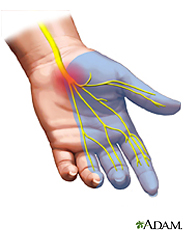 |
 |
 |
Other Health Topics:

-
Related Topics
-
Go Local
- Services and providers for Carpal Tunnel Syndrome in the U.S.
-
National Institutes of Health
- The primary NIH organization for research on Carpal Tunnel Syndrome is the National Institute of Neurological Disorders and Stroke
You're working at your desk, trying to ignore the tingling or numbness you've had for some time in your hand and wrist. Suddenly, a sharp, piercing pain shoots through the wrist and up your arm. Just a passing cramp? More likely you have carpal tunnel syndrome.
The carpal tunnel is a narrow passageway of ligament and bones at the base of your hand. It contains nerve and tendons. Sometimes, thickening from irritated tendons or other swelling narrows the tunnel and causes the nerve to be compressed. Symptoms usually start gradually. As they worsen, grasping objects can become difficult.
What causes the problem? Some people have smaller carpal tunnels than other people do. Other causes include performing assembly line work, wrist injury, or swelling due to certain diseases, such as rheumatoid arthritis. Women are three times more likely to have carpal tunnel syndrome than men. Treatment includes resting your hand, splints, pain and anti-inflammatory medicines, and surgery.
National Institute of Neurological Disorders and Stroke
-
Carpal Tunnel Syndrome
 (National Institute of Neurological Disorders and Stroke)
(National Institute of Neurological Disorders and Stroke)
Also available in Spanish
-
Carpal Tunnel Syndrome: Preventing the Pain in Your Hands and Wrists(American Academy of Family Physicians)
Also available in Spanish
| Basics | Learn More | Multimedia & Cool Tools |
|---|---|---|
|
||
| Research | Reference Shelf | For You |
-
Overviews
- Carpal Tunnel Syndrome(Mayo Foundation for Medical Education and Research)
-
Carpal Tunnel Syndrome
 (National Institute of Neurological Disorders and Stroke) - Short Summary
(National Institute of Neurological Disorders and Stroke) - Short Summary
- Carpal Tunnel Syndrome(American College of Rheumatology)
-
Diagnosis/Symptoms
-
Electrodiagnostic Testing(American Academy of Orthopaedic Surgeons)
Also available in Spanish
- Wrist Pain(Mayo Foundation for Medical Education and Research)
-
Electrodiagnostic Testing(American Academy of Orthopaedic Surgeons)
-
Treatment
-
Carpal Tunnel Syndrome Surgery
 (Patient Education Institute) - Requires Flash Player
(Patient Education Institute) - Requires Flash Player
Also available in Spanish
- Hand Surgery: Anesthesia(American Society for Surgery of the Hand)
-
Joint and Soft Tissue Injections(American Academy of Family Physicians)
Also available in Spanish
- Wrist Arthroscopy(American Society for Surgery of the Hand, American Academy of Orthopaedic Surgeons)
-
Carpal Tunnel Syndrome Surgery
-
Prevention/Screening
-
Carpal Tunnel Syndrome(American Physical Therapy Association)
Also available in Spanish
- Wrist/Palm Supports(Occupational Safety and Health Administration)
-
Carpal Tunnel Syndrome(American Physical Therapy Association)
-
Tutorials
-
Carpal Tunnel Syndrome Surgery(Patient Education Institute) - Requires Flash Player
Also available in Spanish
-
Carpal Tunnel Syndrome Surgery(Patient Education Institute) - Requires Flash Player
-
Videos
- Carpal Tunnel Release(OR-Live) - Requires media player - One hour video - 12/11/2006
-
Anatomy/Physiology
- Atlas of the Body: The Carpal Tunnel(American Medical Association)
-
Clinical Trials
-
ClinicalTrials.gov: Carpal Tunnel Syndrome
 (National Institutes of Health)
(National Institutes of Health)
-
ClinicalTrials.gov: Carpal Tunnel Syndrome
-
Genetics
-
Genetics Home Reference: Hereditary neuropathy with liability to pressure palsies
 (National Library of Medicine)
(National Library of Medicine)
-
Genetics Home Reference: Hereditary neuropathy with liability to pressure palsies
-
Journal Articles
References and abstracts from MEDLINE/PubMed (National Library of Medicine)
- Article: Digital ischemia after carpal tunnel injection: a case report.
- Article: Endoscopic revision of carpal tunnel release.
- Article: Acute carpal tunnel syndrome.
- Carpal Tunnel Syndrome -- see more articles
-
Directories
- Find a Hand Surgeon(American Society for Surgery of the Hand)
- Find an Orthopaedist(American Academy of Orthopaedic Surgeons)
-
Organizations
- American Academy of Orthopaedic Surgeons
- American Society for Surgery of the Hand
-
National Institute of Neurological Disorders and Stroke

Also available in Spanish
-
Statistics
- Repetitive Motion Related Occupational Injuries and Illnesses Involving Days Away from Work, 2006(Bureau of Labor Statistics) - Links to PDF
-
Children
- Carpal Tunnel Syndrome(Nemours Foundation)
| Home | Health Topics | Drugs & Supplements | Encyclopedia | Dictionary | News | Directories | Other Resources | |
| Disclaimers | Copyright | Privacy | Accessibility | Quality Guidelines U.S. National Library of Medicine, 8600 Rockville Pike, Bethesda, MD 20894 National Institutes of Health | Department of Health & Human Services |
Date last updated: 03 September 2008 Topic last reviewed: 16 June 2008 |






